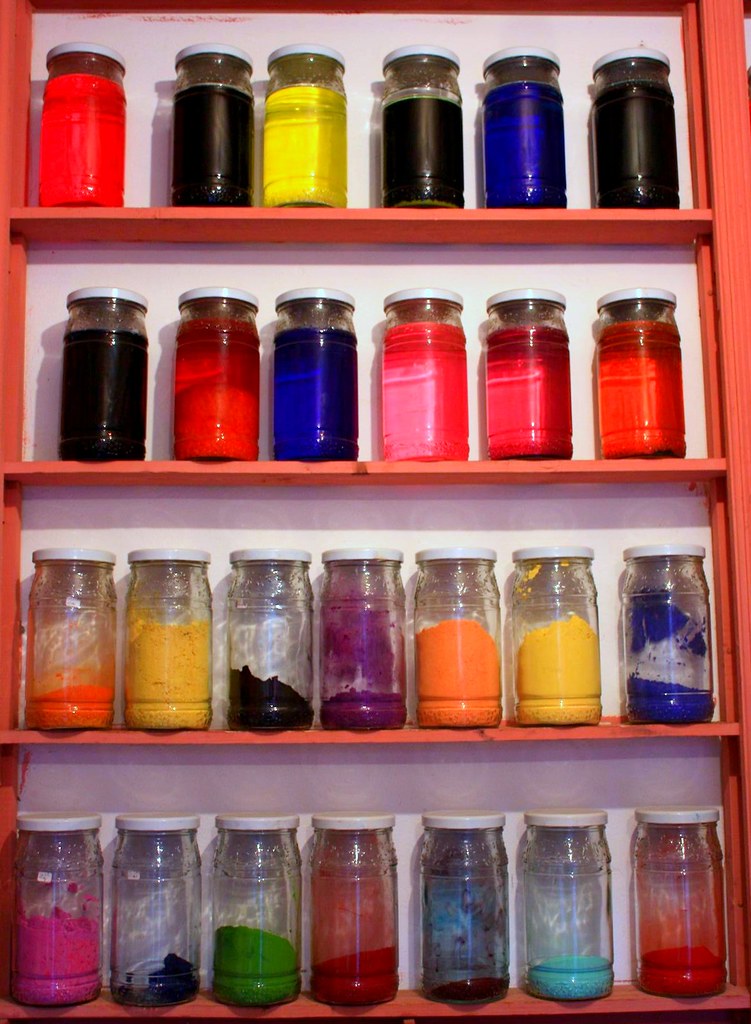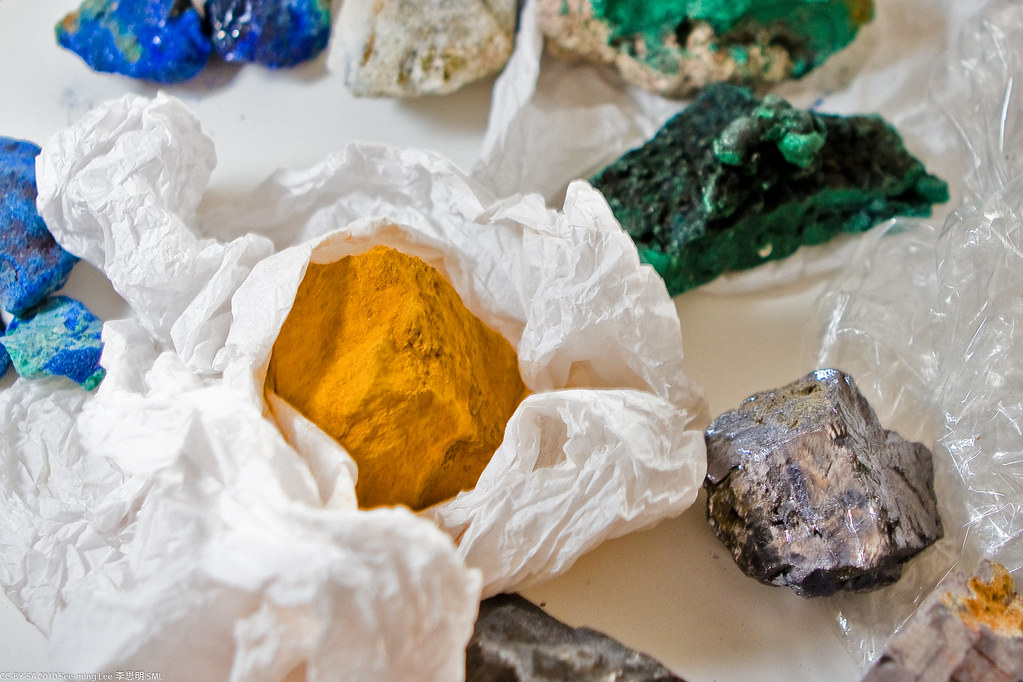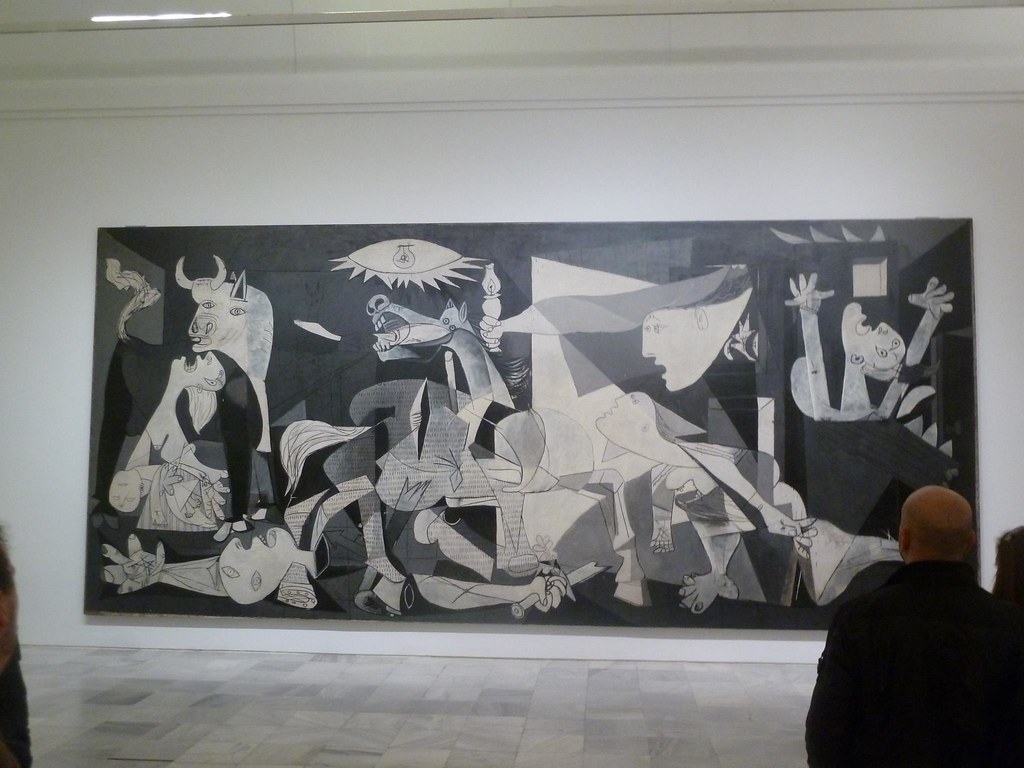Color is considered the most fascinating characteristic of visual perception. It tells a lot about a work of art thanks to its deep influence on the viewer. It creates aesthetic attractiveness and it gives emotions through the use of pigment, the coloring substance of paint.

Image source: https://search.creativecommons.org/photos/7faae771-5b31-4be8-ba9f-842ed7b2b128 by austinevan
What a pigment is
Pigments are powdered substances that are mixed with a liquid. They are used especially to impart color to other materials and they can be organic or inorganic. Organic pigments came from natural sources and have been used for centuries. Nevertheless the most used pigments today are either inorganic or synthetic organic ones. Synthetic organic pigments are derived from coal tars and other petrochemicals. Inorganic pigments are made by simple chemical reactions (especially oxidation) or are found naturally as Earth Pigments.

Image source: https://search.creativecommons.org/photos/018f7e8f-7ab1-49fb-860e-26bc0a800bbb by renovatura
Natural pigments
Natural pigments are derived from nature and can be ground, sifted, washed, and sometimes heated to create the desired hue. Even though their application dates back to 5000 B.C with cave paintings, they continued to be the base for oil paints until the 19th century. Natural dyes can be divided into three categories: pigments obtained from plants, pigments obtained from animals, and pigments obtained from minerals. The first type gives vibrant colors through the use of plants, roots, and flowers of different kinds. The second category is about colors extracted from insects and the third one is about dye which came from rocks and soil and gives vivid colors.

Image source: https://search.creativecommons.org/photos/4b9d67e1-7e63-4988-8f0e-f894616f8cff by See-ming Lee (SML)
Natural Pigments in Prehistory
The oldest pigments can be found in Prehistoric Art with cave paintings, where humans used to leave an imprint on the walls. In the beginning, they drew with soil or charcoal mixed with spit or animal fat, until they started to use mineral pigments. Red and Yellow Ochres were made from Limonite and Hematite minerals, while Black and White dyes came from Manganese and Calcite Ores. Prehistoric people discovered that paint derived from iron oxide deposits didn’t fade as fast as colors from animal or vegetable sources. This was due to the fact that mineral pigments would not fade with the changing environment so men traveled a lot to maintain a steady supply of them. Nowadays the majority of prehistoric settlements show signs which lead to mines or digs where these pigments were obtained.

Image source: https://search.creativecommons.org/photos/f160e92e-7040-4410-ba2d-0491685ba77c by D-Stanley
Natural Pigments in Renaissance
Natural Pigments continued to be used by painters through the Middle Ages and they were mixed with egg and water to create a dried protein that would have bind the pigment to the substrate. In the 15th century, the egg began to be replaced by walnut or linseed oil, which dried slower and created a more versatile paint. The natural brightness and plasticity of oil dyes allowed Renaissance artists to obtain new effects of color and realism. They also used natural chalks made from mineral pigments to draw, following a tradition begun in Stone Age cave painting. The Renaissance palette included many types of colors: there were Naples Yellow, Orpiment, and Lead-tin Yellow, while browns were obtained from umber. The Greens were Verdigris and Malachite, while among the Reds prevailed Carmine Lake. There were also many blues as Azurite, Ultramarine, and Indigo. One of the most iconic paintings of Renaissance Art such as Raphael’s Madonna and Child Enthroned with Saints shows the use of Azurite.

Image source: https://search.creativecommons.org/photos/8f48c56a-4a80-4e78-9f60-40e546fe74a8 by rverc
Synthetic Pigments
In 1704, German chemist Johann Jacob Diesbach created Prussian Blue by accident, creating the first chemically synthesized color. This is a deep blue pigment that is produced when the oxidation of ferrous ferrocyanide salts occurs. It contains ferric hexacyanoferrate (II) in a cubic lattice crystal structure. Despite synthetic dyes are chemically manufactured they started to become a medium to produce art. One of the earliest synthetic pigments was White Lead, made by treating sheets of lead with vinegar. It could keep its color for many centuries and it resists high heat and intense light.

Image source: https://search.creativecommons.org/photos/31cf7df8-da37-44dd-91b3-116540bb8960 by Oregon State University
Pigments during Industrial Revolution
Before the Industrial Revolution, the choice of colors was limited because pigments belonged to the location where they were produced. The 18th and 19th centuries brought new inventions and methods of extracting pigments to extend the range of available colors. In 1841, American painter John Rand invented the collapsible tin paint tube, which was used to squeeze out the paint and preserved it for a longer time. The technique of Plein-air oil painting drastically changed when paints companies develop a method to maintain pigments particles suspended in linseed oil. Painters didn’t need to ground pigments in order to prepare their paints anymore. The 19th century saw also new colors and enhanced versions of pigments as Cobalt Blue in 1807, Cadmium yellow in 1820, and Cerulean Blue in 1860. They were followed by cheap synthetic French Ultramarine, Zinc White, and Cobalt Violet.

Image source: https://search.creativecommons.org/photos/bdc929e0-ffd6-4c89-b000-032cd769c707 by W. Oelen
Pigments in Modern Age
The 19th century saw the rise of a new kind of professional: the Colourman. This figure was a supplier of materials for artists who understood what they wanted but also knew something about chemistry. For this reason, he could test the new colors to see if they were reliable. In that period the palettes of academic painters have been replaced with strong colors that have never been seen on the canvas. Impressionist artists especially created a kind of painting that revolutionized art and scandalized traditionalists. It was characterized by the juxtapositions of the new bright pigments. Chromium, Cobalt, and Cadmium colors were applied in complementary hues side by side to enhance each other’s brilliance.

Image source: https://search.creativecommons.org/photos/ea70adf3-971f-46e4-aefb-dc2b5ace9c0c by oliworx
Pigments in Contemporary Age
The most important painting invention of the 20th century was acrylic paint, composed of pigment particles dispersed in an acrylic polymer emulsion. In the beginning, this water-soluble paint was sold for interior houses but then artists and companies began to explore its potential. It became commercially available in the early 1960s.
Among the pigments discovered in the 20th century the most important is Titanium White, the strongest, most brilliant white color available to artists in the history of art. It came from titanium dioxide and in 1921 American and Norwegian companies began to develop their products for painting. It was used by one of the most iconic artists of that time: Pablo Picasso, who made the Guernica painting using a palette of grey, white and black colors.

Image source: https://emptyeasel.com/guernica-famous-cubist-painting-by-pablo-picasso/
Info sources:
http://www.webexhibits.org/pigments/intro/renaissance.html
https://www.invaluable.com/blog/natural-pigments/
https://www.liquitex.com/us/knowledge/what-is-acrylic-paint/
https://www.invaluable.com/blog/natural-pigments/
https://www.liquitex.com/us/knowledge/what-is-acrylic-paint/
http://www.parisist.com/the-importance-of-color-in-art.php
https://www.frankandoak.com/handbook/style/history-of-colour-pigments
http://www.webexhibits.org/pigments/intro/modern.html
https://en.wikipedia.org/wiki/Acrylic_paint
https://www.britannica.com/technology/pigment
https://www.winsornewton.com/na/articles/art-history/history-metal-paint-tube/
